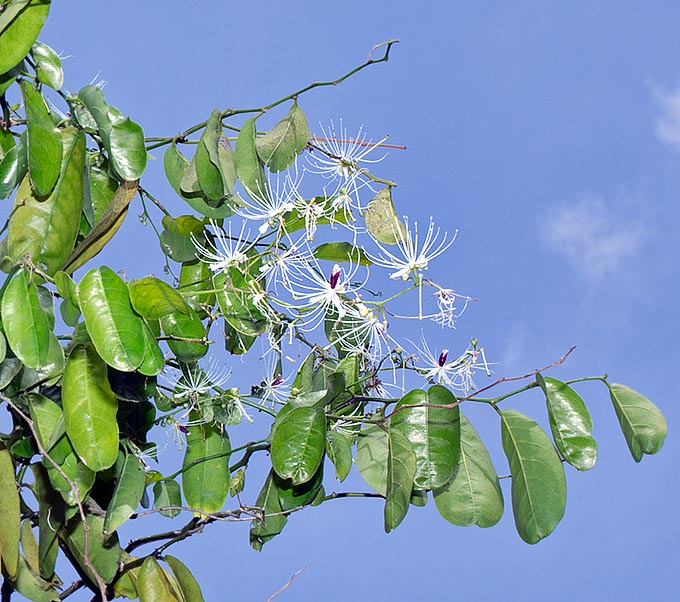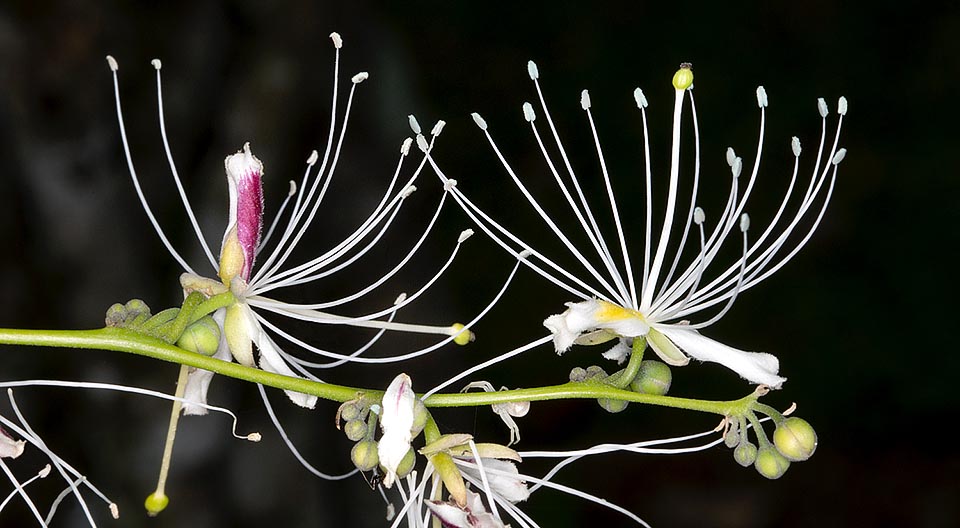Family : Capparaceae

Text © Pietro Puccio

English translation by Mario Beltramini

Native to South-East Asia, Caparis micracantha is a small tree or sarmentose shrub reaching 5 m of height © Mazza
The species is native to Cambodia, China (Guangdong, Guangxi, Hainan and Yunnan), India (Andaman and Nicobar Islands), Indonesia (Java, Kalimantan, Lesser Sunda Islands, Moluccas, Sulawesi and Sumatra), Laos, Malaysia, Myanmar, Philip- pines, Singapore, Taiwan, Thailand and Vietnam where it grows in the bushes and at the margins of the forests, from the sea level up to about 2000 m of altitude.
The name of the genus comes from the Greek “κάππαρις” (kápparis) = caper, already cited by Hippocrates during the V century BC and by Theophrastus (IV century BC), in its turn derived probably from the Arabic “kabbar; the specific name is the combination of the Greek adjective “μικρός” (mikros) = small and of the substantive “ἄκανθα” (akantha) = thorn, with obvious reference.
Common names: caper-thorn (En- glish); ketket kayu joh (Balinese); xiao ci shan gan (Chinese); balung, kledung (Javanese); kanchoen bai dach (Khmer); say sou (Lao); mela- da (Malay); salimbagat (Tagalog); chingchee, nuat maeo daeng (Thai); cáp gai nhỏ, bùng chè, mắm gai (Vietnamese).
The Capparis micracantha DC. (1824) is a sarmentose shrub or a small evergreen tree, 2-5 m tall, with greyish bark and drooping branches provided at the nodes of thorny straight or slightly curved stipules, 1-4 mm long. The leaves, on a 1-1,5 cm long petiole, are simple, alternate, oblong-elliptic to oblong-lanceolate, 10-25 cm long and 5-10 cm broad, with obtuse or pointed apex, coriaceous, of pale green colour, glossy.
Bisexual flowers, in groups of 2-7, arranged in row at the upper axils also without leaves, of 3-4,5 cm of diameter, with 4 oblong-ovate concave sepals, 0,6-1 cm long and 0,4 cm broad, of pale green colour, 4 white petals with an initially yellow stripe tending later to dark purple, pubescent, oblong-lanceolate with rounded apex, 1-2 cm long and 0,4-0,7 cm broad, and 16-40 white stamens 1,8-2,5 cm long.
The fruit is a globose to ellipsoid berry, 3-7 cm long and of 3-4 cm of diameter, with 4 vertical sutures, initially green, dark red when ripe, containing numerous reniform seeds, 0,7 cm long, 0,5 cm broad and 0,3 cm thick, of dark red colour, immersed in a semi-transparent whitish pulp.

The unusual bisexual flowers are in row in groups of 2-7 and reach 3-4,5 cm of diameter. Species locally cultivated as ornamental but known mainly in Asia for many medicinal virtues as analgesic, anti-bacterial, anti-inflammatory, antipyretic, diuretic and for asthma and the hypertension treatment © Giuseppe Mazza
It reproduces by seed in sandy loam maintained humid at the temperature of 24-26 °C.
Species diffused in a vast area of south-eastern Asia where is kept in high consideration by the local populations due to the medicinal virtues that are attributed. The parts of the plant, the modalities of employment and the pathologies for which is employed in the popular medicine differ somewhat from place to place, the most general use is as analgesic, anti-bacterial, anti-inflammatory, antipyretic, diuretic and for the treatment of asthma and of hypertension; its bioactive components are object of researches for a possible use in the official medicine.
It is sometimes cultivated in the tropical and subtropical gardens due to its ornamental flowers, in full sun or at most slightly shaded; is not particular about the soils, provided the same are well draining, but grows best in those rich of organic substance, with moderate waterings, as it does not bear stagnant humidity.
Synonyms: Capparis billardieri DC. (1824); Capparis callosa Blume (1825); Capparis conspicua Wall. (1832); Capparis odorata Blanco (1837); Capparis forsteniana Miq. (1870); Capparis roydsiifolia Kurz (1870); Capparis hainanensis Oliv. (1887); Capparis myrioneura Hallier f. (1906); Capparis bariensis Pierre ex Gagnep. (1908); Capparis donnaiensis Pierre ex Gagnep. (1908); Capparis venosa Merr. (1915); Capparis liangii Merr. & Chun (1934); Capparis petelotii Merr. (1942).
→ To appreciate the biodiversity within the CAPPARACEAE family please click here.
